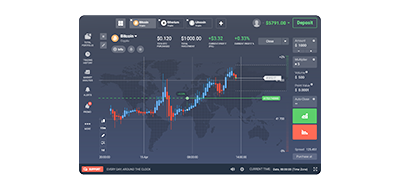กลับ
Contents
What is a Bull Market?

Demetris Makrides
Senior Business Development Manager

Vitaly Makarenko
Chief Commercial Officer
A bull market refers to a period in which the prices of assets, such as stocks, persistently rise or are projected to demonstrate further growth in the future. It is a time when investors have greater confidence and favorable expectations. This article takes a deeper look into the specifics of bull markets, examining their key traits, driving forces, stages and investment approaches commonly used by investors.
Understanding a Bull Market
In the financial world, a bull market signifies more than just a short term surge in prices. It denotes a phase where prices steadily climb, often with noticeable gains. Usually it’s recognized when a broad market index, like the S&P 500, experiences a 20% or greater rise from its low. This positive momentum mirrors robust underpinnings, such as growing corporate earnings, low joblessness rates and an expanding GDP. In times of bull markets that can last for months or even years, investor confidence tends to rise. More people join the market, which in turn boosts the momentum upwards.
Bull may also be seen in non-traditional sectors such as commodities and real estate. Over the last couple of years, crypto has been gaining traction in exhibiting optimistic patterns, despite their inherent volatility. This may be attributed to several causes such as technology advancements and legislative changes, which give rise to substantial upward momentum.
In a bull market, investor sentiment transitions from cautious or bearish to optimistic or bullish as one of the defining characteristics. This positivity is fueled by factors like robust economic indicators, favorable government initiatives and rebounds from market declines. With an influx of investors anticipating price increases, the demand rises, driving prices higher and establishing a self-sustaining loop. In a bull market the positive outlook and heightened trading are indicators that could result in substantial wealth growth for prudent investors.
Characteristics of a Bull Market
In a bull market, there are specific elements that set it apart from other market scenarios. The primary and most apparent feature is the rise in asset values across various sectors. This uptrend in prices is not confined to one sector or a single type of asset but typically mirrors an overall improvement in economic circumstances that positively impacts multiple sectors of the economy.
In a bull market scenario, investors often feel optimistic about the market’s direction. This positive outlook doesn’t just follow the trend in prices; it actually plays a significant role in driving them up further. When investors have confidence in the market’s expansion, they are inclined to gravitate into higher-risk assets such as stocks, cryptocurrencies, and developing market shares. Such an enthusiastic adoption of these assets is driven by the prospect of higher profits and may lead to increased trading activity and much more market liquidity than usual.
In the world of cryptocurrency trading and investment, trends can sway dramatically during bull markets due to factors such as new technologies coming into play, regulations changing and overall economic conditions shifting. Notably in 2017 the surge in cryptocurrency values was largely a result of more people embracing blockchain technology and the rapid expansion of initial coin offerings. Likewise the most recent bullish trend from 2020 to 2021 was mainly propelled by institutions getting on board with cryptocurrencies, the emergence of decentralized finance (DeFi) and an increasing recognition of digital currencies as a legitimate investment option. The next bull market in crypto will seemingly be built on crypto ETFs.
During market uptrends, markets usually see a rise in trading activity and heightened investor interest as prices climb higher, attracting more participants seeking to benefit from the upward movement in the market. Establishing a cycle of positive reinforcement that may extend the period of market optimism and growth is made possible by the increasing input of funds, which forces and drives the prices further higher.
Bull markets do not last forever, therefore it’s important to remember that. When prices rise significantly, values reach levels that raise concerns about overpricing and the possibility of a market downturn or reversal. Having a grasp of the traits and inner workings of a bull market can aid investors in making well informed choices and navigating through these growth phases more effectively. Regardless of whether it’s in financial markets or the realm of cryptocurrencies, being able to identify the indications of a bull market and responding appropriately can greatly contribute to achieving success with both short term long term investments.
Factors Driving a Bull Market
A combination of circumstances and economic and psychological factors usually fuel the bull market and lie at the heart of boosting the asset values upward. On the economic side of things, a flourishing economy featuring robust GDP growth, low unemployment statistics and increasing profits for companies lays a strong groundwork for a bull market. These favorable economic signs hint at businesses making good profits, sound consumer spendings and overall growth in economic activities. This kind of environment naturally builds up investor trust and a stronger inclination to invest in stocks and other forms of assets.
Monetary policy plays a role in fueling bull markets too. When central banks put in place policies like slashing interest rates or going for quantitative easing measures, it brings down the cost of borrowing. Lower interest rates make it easier for businesses to fund their growth and for folks to borrow money and splurge a bit – which in turn gives a boost to the economy’s expansion gears! Also, since returns on investments like bonds are lower with decreased interest rates, investors often turn towards the stock market looking for returns – pushing up the prices of different investments and such. Stimulating the economy through bank measures can significantly support a bullish market trend.
The emotions and mindset of investors are factors in fueling upward trends in the stock market too. Good news like strong financial reports or advancements in technology can make investors feel hopeful and positive about the future of their investments, prompting them to buy more stocks in anticipation of growth and better profits ahead. When investors believe prices will keep going up due to positive news and developments, that boosts confidence in the markets trajectory. It can trigger a cycle where rising prices draw in even more buyers eager to ride the wave of success. Bullish emotion in the cryptocurrency market may be magnified by factors such as extensive adoption, legal clarity, or technical progress, resulting in swift price surges.
Factors like market momentum and the actions of investors can also play a part in fueling a bullish market trend to drive prices up higher on the upward path. Momentum-driven investors and automated trading systems might jump into the market as prices climb higher and thus boost the momentum even more. Big players in the game, like pension funds and hedge funds, can wield influence over how the market behaves because of their substantial capital holdings. When these organizations increase their investments and exposure in the markets in stocks or other financial instruments, it can lead to more buying activity that bolsters the overall momentum of the bull market.
Phases of a Bull Market
In most cases, bullish markets follow specific stages, with unique market patterns and investor attitudes in each phase. Knowing these stages can assist investors in navigating the market and making good choices.
The initial stage of a bull market usually comes after a previous bear market or economic decline period has finished. The prices are typically lower during this phase. There is a general sense of pessimism among investors with some still cautious about any further drops in the market. However, as certain economic signs show progress, such as corporate profits increase, consumer expenditure or positive monetary strategies, intelligent investors begin to see the possibility of a rebound. In these early stages of a bullish market cycle those who are quick to embrace new trends start purchasing assets at lower prices, which kickstarts the upward trajectory of the market.
As the market uptrend enters its next stage, economic conditions are on the upswing and investor trust is on the rise. This period is usually defined by prices steadily climbing, trading activity picking up and a wider range of people getting involved in the market. More investors start joining, buoyed by economic indicators and the ongoing upward trend in asset values. During this phase there’s a feeling of positivity and a belief that the good times will keep rolling on. During the stage of the market cycle is when most of the gains occur as prices rise and more investors join in on the upward trend.
The last stage of a market is usually the most exciting and is known for being filled with enthusiasm and risky, speculative behavior by investors looking to catch up on potential gains. In this stage, we see an occurrence of FOMO – the fear of missing out, when investors are so afraid of missing out on profits that they make decisions based on emotions and belief that prices will continue to go up. Speculative ventures become widespread as individuals seek fast returns on investments.This phase is also identified by bloated values where the rapid rise in asset prices might not be justified by the underlying economic realities and cannot be realistically sustained. During this stage of the process when profits can be substantial is also the time when the market’s at its most susceptible to a downturn or change in direction.
At some point the market goes as high as it can. Prices become too high to sustain for long periods of time. That can happen due to reasons like interest rates going up or the economy slowing down or bad events in politics changing people’s feelings about the market. When investors start selling off stocks to secure a profit or leave the market altogether, the prices may start going down, which shows that the good market times are ending. This drop can lead to a correction in the market where prices go down by 10% or even lower than that .It could also be the start of a bear market, with longer and bigger price drops.
In the world of cryptocurrency trading and investment, these cycles can happen quickly because of how unpredictable the market is and how much emotions influence the market, too. Knowing about the phases that a bull market goes through can give investors an edge by helping them predict when things might change direction and make smarter choices about where to invest their money and when to cash out.
Investing in a Bull Market
In a bull market, people make the most of rising asset prices while keeping an eye on risks involved. One common and simple strategy is to buy and hold assets for the long term, expecting prices to go up steadily in the bullish market. This method lets investors enjoy the growing value of their investments as the market keeps moving up with time. In a lasting bullish market characterized by a consistently positive overall trend is where this strategy truly shines in terms of effectiveness.
In a bull market, a dollar-cost averaging strategy can be quite an effective strategy to consider. This means investing in assets at regular intervals with the same amount of money regardless of what their current prices are. The dangers of attempting to time the market perfectly and mitigating the consequences of short-term swings are both avoided with this strategy.
It is very necessary to have a diversified portfolio in order to ensure the success of an investing plan. Because of the possibility that their prices would increase, growth stocks are often the subject of interest during a bull market. In spite of this, it is not a bad idea for investors to diversify their portfolios by including assets that have historically shown growth during times when markets are generally increasing. This could involve sectors like technology, customer discretionary and financial services, which tend to perform well when economic confidence is high. In crypto investing, it’s vital to spread your investments across a range of coins and tokens. This includes options like Bitcoin and Ethereum along with newer altcoins that could hold promising growth prospects. Furthermore, adding other types of investments, like commodities, real estate or global stocks can help diversify your portfolio and open up new avenues for growth and profit.
Investors with a greater risk appetite and a willingness to make bold moves in the market realm can consider utilizing margin trading – using borrowed funds to enhance investment positions as a means to boost profits in favorable market conditions like a bull run or upward trend in the market cycle. However; it is vital for such individuals to understand that this strategy comes with heightened risks, as potential losses can be significantly increased if market conditions turn unfavorable or take a downturn unexpectedly. Therefore, it is imperative for those who opt for leveraging strategies to have a defined plan for exiting their positions and also be mindful of the likelihood of facing margin calls, should there be sudden and adverse fluctuations in the price levels.
Some investors might opt to use sector rotation tactics by moving their investments into sectors projected to perform well during various phases of a bullish market cycle. During the initial phases of a bull market, cyclical stocks, including those in the industrial or financial sectors, may experience substantial gains as the economy begins to recover. As the bull market progresses, technology and growth oriented stocks might dominate as economic expansion gains momentum, allowing investors to maximize returns while balancing various risks involved in the market.
Conclusion
It is essential for investors to grasp the concept and functioning of a bull market to take advantage of trends in financial markets effectively. By acknowledging the stages of a bull market and using various investment tactics while staying mindful of the risks involved, investors can maneuver through these periods of growth with more assurance and maximize the opportunity for financial gain.
อัปเดต:
19 ธันวาคม 2567

